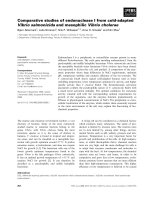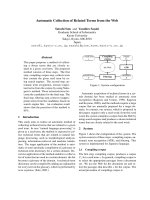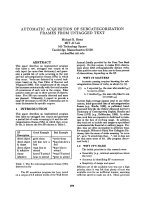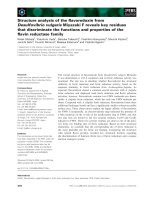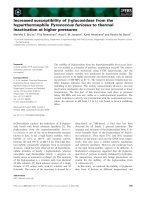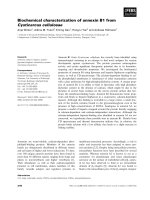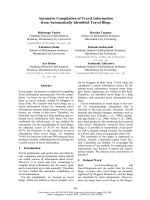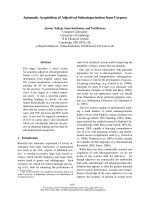báo cáo khoa học: "Low frequency of inversion-carrying chromosomes in a population of Drosophila melanogaster from a cellar habitat" ppsx
Bạn đang xem bản rút gọn của tài liệu. Xem và tải ngay bản đầy đủ của tài liệu tại đây (801.66 KB, 10 trang )
Low
frequency
of
inversion-carrying
chromosomes
in
a
population
of
Drosophila
melanogaster
from
a
cellar
habitat
Ana
GONZÁLEZ
J.L.
MÉNSUA
Departamento
de
Geno!tica,
Facultad
de
Ciencias
Biol6gicas,
Universidad
de
Valencia,
Dr.
Moliner,
50,
Burjassot,
Valencia,
Spain
Summary
The
inversions
of
the
3rd
chromosome
are
studied
in
2
neighbouring
populations
of
Drosophila
melanogaster,
one
from
a
cellar
habitat,
and
the
other
from
a
vineyard
outside.
The
cellar
population
shows
a
lower
frequency
of
chromosomes
with
inversions
than
the
outside
population.
In
the
cellar,
the
average
homozygote
viability
for
inversion-carrying
chromosomes
is
smaller
than
for
inversion-free
chromosomes.
In
the
vineyard
population
there
are
no
differences
between
the
2
types
of
chromosomes.
Key
words :
Drosophila
melanogaster,
inversion,
adaptability,
viability,
cellar.
Résumé
Faible
fréquence
de
chromosomes
avec
inversion
dans
une
population
de
Drosophila
melanogaster
d’un
habitat
de
cave
On
a
étudié
les
inversions
du
3e
chromosome
de
2
populations
voisines
de
Drosophila
melano-
gaster,
l’une
d’un
habitat
de
cave
et
l’autre
d’un
vignoble.
La
population
de
la
cave
présente
une
plus
faible
fréquence
de
chromosomes
avec
inversion
que
la
population
extérieure.
En
cave,
les
chromosomes
avec
inversion
sont
moins
viables,
à
l’état
homozygote,
que
les
chromosomes
sans
inversion.
Dans
la
population
extérieure,
il
n’existe
pas
de
différence
de
viabilité
entre
les
2
types
de
chromosomes.
Mots
clés :
Drosophila
melanogaster,
inversion,
adaptabilité,
viabilité,
cave.
1.
Introduction
Drosophila
melanogaster
is
a
chromosomally
polymorphic
species,
as
has
been
confirmed
in
various
natural
populations
by
many
workers
in
this
field
(A
S
i-r
BURNER
&
LE
ME
UNIER
,
19!IG ;
CH
oi,
1977 ;
M
ETNER
et
al. ,
19!I ;
I
NOUE
&
W
ATANABE
,
1979 ;
P
AIK
,
1979 ;
Z
ACI3
AROPOU
iou
&
P
ELECANOS
,
1980 ;
K
NIBB
et
al. ,
1981,
I
NOUE
et
al. ,
1984).
Particular
studies
in
this
species
suggest
that
the
presence
or
absence
of
chromo-
somal
inversions
might
be
involved
in
the
adaptability
of
populations
to
given
environ-
ments
(Krriss
et
al.,
1981),
and
include
associations
of
inversion
frequencies
in
some
natural
populations
with
food
type,
size
of
sperm
load
in
females,
yearly
seasons
or
wing-load
index
and
flying
ability
at
low
temperatures
(S
TALKER
,
1976 ;
1980).
However,
there
have
been
few
studies
on
inversion
polymorphism
in
natural
populations
from
specific
ecological
situations
or
habitats.
Cellars
constitute
a
peculiar
environment
for
Drosophila.
The
factors
which
cons-
titute this
environment
are
diverse
and
complex :
a
high
concentration
of
alcohol
(espe-
cially
ethanol),
a
greater
uniformity
of
temperature
and
humidity
throughout
the
year,
limited
space,
scarcity
of
light,
etc.
Drosophila
melanogaster,
which
is
the
most
abundant
Drosophila
species
in
this
habitat
(M
ONCLUS
&
PREVOS!rt,
1978),
must
adapt
to
all
these
factors.
This
study
attempts
to
determine
the
nature
of
the
chromosomal
polymorphism
in
a
cellar
population
of
Drosophila
melanogaster,
and
in
a
population
from
outside
the
cellar,
and
to
determine
whether
the
presence
or
absence
of
inversions
might
be
important
in
the
adaptation
of
D.
melanogaster
to
the
cellar
habitat.
The
fitness
of
chromosomes
was
estimated
by
measuring
their
viabilities.
II.
Material
and
methods
At
the
end
of
October
1979
simultaneous
captures
of
Drosophila
melanogaster
were
made
in
2
relatively
distinct
habitats
near
Requena
(Valencia-Spain) :
a
cellar
and
an
outside
location
(vineyard)
about
4
km
from
the
cellar.
On
the
days
of
capture
the
temperatures
in
the
vineyard
reached
minima
of 3
°C
to
4
°C
and
maxima
of
7
°C
to
8
d
c.
In
the
cellar
the
temperatures
varied
between
11
°C
and
14
°
C.
The
relative
humidity
was
55-58
p.
100
in
the
vineyard
and
51-53
p.
100
in
the
cellar.
The
flies
were
aspirated
individually
by
suction
into
glass
vials,
and
then
transferred
into
culture
bottles.
A.
Extraction
and
maintenance
of
third
chromosomes
Each
male
captured
in
the
wild,
or
one
single
son
from
each
female
inseminated
in
the
wild
and
isolated
at
the
place
of
capture,
was
crossed
with
3
virgin
Ub
X’
30
es/CSb
females
(Ubx :
ultrabithorax,
which
is
included
in
In(3LR)TM2).
In
the
following
generation
a
single
phenotypically
Ubx
male
from
the
progeny
of
each
cross
was
again
crossed
with
three
Ubx/Sb
females.
In
order
to
maintain
the
chromosomes
as
lines,
in
each
generation
Ubx/+i
males
(i
=
n°
of
line)
were
crossed
with
virgin
Ubx/CSb
females.
Maintaining
the
chromosomes
in
this
way
allowed
first
of
all
an
estimation
of
the
relative
viabilities
of
chromosome
groups
at
given
times
and
secondly,
overcomes
the
problem
that
when
stocks
are
maintained
in
cage
populations
(I
NOUE
,
1979)
or
as
isolines
(I
NOUE
,
quoted
by
K
NIBB
et
al.,
1981),
the
cosmopolitan
inversions
tend
to
be
eliminated
after
several
generations.
B.
Estimation
of
relative
viability
The
homozygote
and
heterozygote
relative
viabilities
of
the
3rd
chromosome
were
estimated
as
follows :
crosses
were
made
between
4
Ubx/+i
females
and
4
Ubx/+i
males
with
2
simultaneous
replications
in
each
chromosome
line,
where
&dquo;i&dquo;
indicates
line
number.
In
the
offspring,
Ubx/+i
flies
segregate
at
an
expected
ratio
of
2 :
1.
The
relative
viabilities
of
random
heterozygotes
were
estimated
in
a
way
similar
to
the
above,
combining
2
successively
numbered
lines,
i.e.,
Ubx/+i
x
Ubxl+i+1
in
order
to
secure
random
combination
of
different
chromosome
lines.
In
both
cases,
4
days
after
the
crosses
were
made,
all
8
flies
in
a
vial
were
transferred
to
a
second
vial.
Four
days
after
the
transfer,
all
flies
were
discarded.
In
both
the
original
and
the
transferred
vials,
all
flies
were
counted
3
times
until
the
18th
day
after
the
cross
or
transfer
was
made.
Ubx
flies
and
wild
type
flies
from
the
pair
of
vials
were
respectively
pooled
and
considered
as
a
single
observation.
Relative
viability
was
expressed
as
the
ratio
of
(the
number
of wild
type
progeny
flies)
to
(the
number
of
Ubx
progeny
flies
+
1)
(cf.
HA
LDA
NE
,
1956).
C.
Detection
of
inversions
Cytological
examination
of
the
salivary
chromosomes
in
the
balanced
lines
was
difficult
because
of
the
presence
of
Ubx
chromosomes.
Two
Ubx/+i
males
were
therefore
crossed
whith
3
virgin
&dquo;rucuca&dquo;
females
(a
strain
which
is
homozygous
for
the
standard
arrangement).
Two
rucuca/+i
males
of
the
F,
were
then
crossed
with
3
virgin
&dquo;rucuca&dquo;
females.
Third
instar
larvae
were
collected
from
the
progeny
of
this
latter
cross,
and
their
salivary
glands
extracted.
Lactic-acetic
orcein
(80/20)
for
45
min
was
used
to
stain
the
chromosomes,
followed
by
the
usual
squashing
technique.
Eight
preparations
of
each
chromosome
line
were
observed
and
a
given
chromosome
line
was
considered
not
to
carry
inversions
when
no
inversions
appeared
in
any
of
the
8
preparations.
The
theoretical
probability
of
not
choosing
a
heterozygous
&dquo;rucuca&dquo;
larva
when
observing
the
8
preparations
is
(1
h)
8
=
0.0039.
The
nomenclature
of
already-known
inversions
is
that
of
L
INDSLEY
&
G
RELL
(1972).
The
inversion
break-points
were
established
by
comparing
photographs
with
photographic
representations
of
BRIDGES’
(1935)
standard
maps
(L
EFEVRE
,
1976).
III.
Results
In
a
previous
study
(G
ONZALEZ
,
1985),
155
cellar
and
145
vineyard
third
chromo-
somes
were
analysed
for
viability.
In
the
cellar,
the
average
homozygote
viability,
computed
on
the
basis
of
an
average
heterozygote
viability
of
1.000,
was
0.401
±
0.025
if
lethal
lines
were
included
and
0.519
±
0.025
if
they
were
excluded.
In
the
vineyard,
the
average
homozygote
viability
was
0.367
±
0.025
including
lethal
lines
and
0.493
±
0.026
excluding
them.
In
the
present
study
161
third
chromosomes
out
of
the
300
of
the
previous
study
have
been
analysed
cytologically
for
inversions
(86
from
the
cellar
population
and
75
from
the
vineyard).
Of
these
chromosomes,
78
were
lethal
carriers
(38
from
the
cellar
and
40
from
the
vineyard).
A.
Description
of
inversions
The
inversions
found
in
the
2
populations
under
consideration
were
classified
according
to
the
categories
adopted
by
I
NOUE
&
W
ATANABE
(1979),
which
are
modifi-
cations
of those
of
M
ETTLER
et
al.
(1977).
&dquo;Common
cosmopolitan
inversions&dquo;
are
the
most
frequent
world-wide
inversions
and
occur
on
every
major
autosomal
arm.
&dquo;Rare
cosmopolitan
inversions&dquo;
are
distributed
world-wide
but
at
a
lower
frequency
than
the
common
cosmopolitan
inversions.
&dquo;Recurrent
endemic
inversions&dquo;
are
restricted
to
certain
regions.
&dquo;Unique
endemic
inversions&dquo;
are
usually
observed
in
a
single
individual
or
its
brood
from
a
single
population,
and
never
found
in
a
different
population.
Five
different
inversions
were
found
on
the
3rd
chromosomes
from
the
populations
studied,
as
detailed
below.
Of
these,
4
were
found
on
the
3R
and
one
the
3L
arm :
3
isolated
chromosomes
had
more
than
one
inversion,
and
each
of
these
had
both
In(3L)P
and
In(3R)P,
indicating
no
significant
linkage
disequilibrium
either
overall,
or
within the
2
populations.
The
3
chromosomes
with
these
inversions
linked
were
lethal
carriers,
and
by
allelism
analysis
it
was
confirmed
that
they
were
not
allelic
lethals.
It
will
be
seen
that
the
majority
of
inversions
found
in
these
populations
are
cosmopolitan.
However,
a
unique
endemic
inversion
on
the
3R
arm
has
been
found
with
breakpoints
at
86E-92F
(fig.
1).
B.
Frequencies
of
the
inversions
The
number
of
chromosomes
examined
and
the
frequencies
of
the
various
gene
arrangements
are
given
in
table
1.
The
results
indicate
that
although
In(3L)P
and
In(3R)P
each
occur
at
a
higher
frequency
in
the
vineyard
than
in
the
cellar
population,
these
differences
are
not
statistically
significant.
However,
when
all
inversions
are
pooled
there
is
a
significant
difference
between
populations.
In
the
cellar
population
12
inversion-carrying
chromosomes
were
found
(13.95
p.
100
±
2.73)
and
21
in
the
vineyard
population
(28.00
p.
100
±
3.53).
The
difference
between
the
2
frequencies
is
significant
at
the
0.05
level
(t
=
2.21,
df
=
159,
p
<
0.05).
C.
Association
of
lethals
and
inversions
Table
2
shows
the
frequencies
(p.
100)
of
standard
and
inversion
arrangements
present
in
the
lethal-carrying
and
lethal-free
chromosomes
from
the
cellar
and
vineyard
populations.
We
tested for
possible
associations
of
lethals
with
inversions
before
and
after
pooling
the
2
populations
samples.
In
both
cases
a
slightly
higher
frequency
of
inversions
was
observed
in
the
lethal-carrying
chromosomes
than
in
the
lethal-free
chromosomes.
However,
in
no
case
was
the
association
significant.
D.
Relative
viabilities
of
third
chromosomes
in
homozygotes
and
heterozygotes
Average
homozygote
viability
for
inversion-free
chromosomes
from
the
cellar
was
significantly
greater
than
that
of
the
cellar
inversion-carrying
chromosomes,
and
those
of
the
vineyard
inversion-free
or
inversion-carrying
chromosomes,
whether
or
not
lethals
were
considered
(table
3).
While
sampling
error
may
have
contributed
to
these
results
it
should
be
noted
that
there
were
no
significant
differences
between
the
average
homozygote
viabilities
of
the
chromosomal
sample
analysed
in
the
present
work
(86
chromosomes
including
the
lethals
and
48
excluding
them)
and
the
average
homozygote
viabilities
from
a
greater
chromo-
somal
sample
(155
chromosomes
including
the
lethals
and
117
excluding
them)
estimated
previously
(G
ONZALEZ
,
1985).
The
average
viabilities
of
heterozygous
homokaryotypes
(STi/STj)
and
heterokaryo-
types
(ST/IN)
of
the
two
populations
were
also
compared
(table
4).
There
were
no
significant
differences
either
in
the
cellar
or
in
the
vineyard
populations.
Discussion
and
conclusions
The
cosmopolitan
inversions
of
the
3rd
chromosome
of
Drosophila
melanogaster
in
the
cellar
population
of
the
present
study
show
frequencies
which
lie
inside
the
range
found
in
a
survey
of
12
cellars
in
different
Spanish
localities :
In(3L)R
.= 0.6
p.
100
-
9.5
p.
100 ;
In(3R)P -
1.5
p.
100 -
12
p.
100 ;
In(3R)C
=
0 p.
100 -
6.4
p.
100
(P
REVOS
’n,
personal
communication) ;
this
survey
also
indicated
the
presence
of
endemic
inversions
in
the
majority
of
the
cellars
studied.
In
the
cellar
studied
here,
an
endemic
inversion,
not
previously
described,
has
been
found
[In(3R)Bol ;
86E-92F],
and
in
a
study
made
with
flies
from
the
same
cellar,
maintained
in
the
laboratory,
another
endemic
inversion,
[In(3R)Boll ;
87C-93D],
has
also
been
found which
had
not
been
described
previously
(N
AJERA
,
1985).
The
data
regarding
the
total
frequency
of
inversions
of
the
third
chromosome
indicate
a
lower
frequency
in
the
cellar
than
in
the
vineyard
population.
It
should
be borne
in
mind
that
although
the
sample
sizes
are
not
especially
large,
they
were
of
the
same
order
in
both
populations.
The
sizes
are
sufficiently
great
to
detect
differences
between
inversion-free
and
inversion-carrying
chromosomes
with
a
probability
of
70
p.
100
at
the
0.05
level
of
significance.
It
may
be
thought
that
drift
processes
play
an
important
role
in
determining
the
frequencies
of
inversion-carrying
chromosomes.
However,
the
effective
sizes
estimated
in
both
populations
were
Ne -=
8
000
for
the
cellar
and
Ne
=
12 000
for
the
vineyard
(G
ONZALEZ
,
1985).
These
values
indicate
that
both
populations
are
relatively
large
and
therefore
the
effect
of
drift
in
them
should
theoretically
be
small.
It
is
considered
that
the
factors
associated
with
the
cellar
habitat
create
different
adaptive
responses
in
Drosophila
melanogaster
from
those
produced
by
the
vineyard
habitat,
and
that
the
inversions
seem
to
be
involved
in
some
way
in
these
responses.
S
TALKER
(1976 ;
1980)
found
an
association,
in
Drosophila
melanogaster,
between
diffe-
rent
ecological
niches
(i.e.
different
food
resources)
and
particular
inversions.
The
presence
of
alcohol
(principally
ethanol)
at
high
concentrations
is
one
of
the
most
salient
characteristics
of
the
cellar.
However,
alcohol
is
not
the
only
characteristic
component
of
wine
and
there
are
related
products
present
in
the
cellars
that
can
be
used
as
food
for
the
flies
(M
ONCLUS
&
P
REVOS
TI,
1978).
The
availability
of
ecological
niches
which
can
be
used
by
Drosophila
is
lower
in
cellars
than
in
vineyards,
although
McKENZIE
&
PARSONS
(1974)
detected
microdifferen-
tiation
in
a
cellar
population
of
Drosophila
melanogaster.
This,
according
to
DA
C
UNHA
&
D
OBHANSKY
(1954),
would
imply
less
chromosomal
polymorphism
in
the
cellar,
and
consequently,
a
lower
level
of
structural
heterozygosity
in
these
populations.
The
data
on
chromosome
viability
from
cellar
and
vineyard
seem
to
support
the
idea
that
the
absence
of
inversions
could
be
important
in
the
adaptation
of
Drosophila
melanogaster
to
the
cellar
habitat.
It
is
observed
on
the
one
hand,
that
in
neither
of
the
2
populations
are
there
differences
in
the
average
heterozygote
viabilities
of
genotypes
which
are
structurally
homozygous
and
heterozygous.
On
the
other,
the
average
homo-
zygous
viabilities
of
inversion-free
chromosomes
from
the
cellar
are
greater
than
those
of
cellar
inversion-carrying
chromosomes
and
both
types
of
chromosomes
from
the
vineyard
population.
It
must
be
pointed
out,
though,
that
laboratory
conditions
are
never
similar
to
nature.
The
viabilities
of
the
chromosomes
of
both
populations
were
analysed
under
the
same
conditions
and
it
has
been
assumed
that
the
fitness
estimated
can
reflect
the
relative
behaviour
of
the
chromosomes
in
each
of
their
respective
habitats,
without
taking
into
account
the
possible
distortions
due to
genotype-environment
inter-
actions
(T
ACMDA
&
M
UKAI
,
1985).
I
NOUE
(1979)
observed,
during
the
maintenance
of
wild
caught
Drosophila
melano-
gaster
as
laboratory
populations,
that
the
total
frequency
of
all
inversions
as
well
as
the
frequency
of
each
inversion
decreased,
and
that
the
inversion-carrying
chromosomes
were
disadvantageous
compared
with
the
standard
chromosomes.
W
ATANABE
et
al.
(1976),
analysing
chromosomes
of
a
cage
population,
found
that
the
inversion-free
lines
had
greater
homozygote
viability
than
those
with
inversions,
but
that
the
heterozygote
viability
was
similar
for
both
chromosome
types.
Thus,
the
behaviour
of
the
chromosomes
from
the
cellar
is
analogous
to
that
of
the
chromosomes
from
these
cage
populations.
However,
in
other
natural
populations
of
Drosophila
melanogaster,
it
seems
that
the
standard
and
inversion-carrying
chromosomes
do
not
differ
in
their
relative
viabilities
either
in
the
homozygous
or
the
heterozygous
state
(MuKAi
&
Y
AMAGUCHC
,
1974 ;
K
USAKABE
&
MuKAi,
1984 ;
T
ACHIDA
&
MuKAi,
1985).
This
behaviour,
then,
is
similar
to
that
of
the
chromosomes
from
our
vineyard
population.
In
accordance
with
this,
it
would
be
possible
to
suppose
that
the
inversions
were
introduced
into
the
cellars
from
outside
and
here,
as
homozygotes,
they
were
being
selected
against
every
generation.
Theoretically,
then,
the
cellar
populations
should
tend
towards
monomorphism,
but
in
practice
this
does
not
happen.
Perhaps
this
is
because
the
cellar
is
not
a
totally
isolated
population
and,
particularly
at
the
grape
harvest
(end
of
September),
there
is
a
migration
of
flies
from
outside.
The
low
frequency
of
inversion-carrying
chromosomes
in
the
cellar
compared
to
the
vineyard
population
could
also
be
influenced
by
the
differing
behaviour
of
the
2
populations
in
response
to
seasonal
changes.
Because
of
the
semi-open
habitat
of
the
cellar,
changes
in
the
weather
could
affect
cellar
populations
less
than
those
which
live
outside.
Particular
populations
of
Drosophila
melanogaster
show
seasonal
changes
in
the
frequencies
of
standard
sequence
chromosomes
(S
TALKER
,
1980 ;
Z
ACHAROPOUPO
-
L
ou
&
P
ELECANOS
,
1980) :
at
the
beginning
of
spring
they
have
relatively
higher
frequen-
cies
of
standard
arrangements,
reflecting
a
pattern
of
selection
favoring
such
arrangements
during
the
coldest
months
of
the
year.
Such
high
frequencies
appear
reduced
by
selection
during
the
warm
months,
and
are
restored
again
in
the
following
winter.
These
seasonal
changes
are
shown
by
populations
where
there
are
sharp
changes
in
temperature
between
winter
and
summer
(S
TALKER
,
1980),
which
is
a
similar
situation
to
that
of
the
vineyard
population.
Our
collections
were
made
at
the
end
of
October,
a
time
at
which,
theo-
retically,
there
should
be
relatively
high
frequencies
of
inversion-carrying
chromosomes.
If
the
seasonal
changes
affect
the
vineyard
population,
but
not
that
of
the
cellar,
then
the
results
obtained
could
be
a
reflection
of
this.
Regarding
association
of
inversions
and
lethals,
the
results
of
this
study
show
that
inversion-carrying
chromosomes
have
slightly
higher,
albeit
not
significantly
so,
frequen-
cies
of
lethals
than
the
standard
chromosomes.
Other
studies
in
some
populations
of
Drosophila
melanogaster
show
clearly
that
the
inversion-carrying
chromosomes
carry
lethals
more
frequently
than
inversion-free
chromosomes
(W
ATANABE
&
W
ATANABE
,
1973 ;
M
UKAI
&
Y
AMAGUC
HI,
1974 ;
W
ATANABE
et
al. ,
1976 ;
but
see
W
ATANABE
&
Y
AMAZAKI
,
1976).
It
is
possible
that
our
results
of
no
association
between
lethals
and
inversions
might
be
due
to
a
not
too
large
sampling
number.
Received
July
24,
1986.
Accepted
December
2,
1986.
References
A
SHBURNER
M.,
L
EMEUNIER
F.,
1976.
Relationships
within the
melanogaster
species
subgroup
of
the
genus
Drosophila
(Sophophora).
I.
Inversion
polymorphisms
in
Drosophila
melanogaster
and
Drosophila
simulans.
Proc.
Roy.
Soc.,
Lond.
B.,
193,
137-157.
BRIDGES
C.B.,
1935.
Salivary
chromosome
maps
with
a
key
to
the
banding
of
the
chromosomes
of
Drosophila
melanogaster.
J.
Hered.,
26,
60-64.
C
HOI
Y.,
1977.
Chromosomal
polymorphism
in
a
Korean
natural
population
of
Drosophila
melano-
gaster.
Genetica,
47,
155-160.
DA
C
UNHA
A.B.,
DoszHwtvsxY
T.H.,
1954.
A
further
study
of
chromosomal
polymorphism
in
Drosophila
willistoni in
its
relation
to
the
environment.
Evolution,
8,
119-134.
Go
N
Zwr.EZ
A.,
1985.
Estudio de
la
estructura
genitica
de
dos
poblaciones
naturales
de
Drosophila
melanogaster
respecto
a
genes
que
afectan
a
la
viabilidad.
Thesis,
Universidad
Valencia.
H
ALDANE
J.B.S.,
1956.
Estimation
of
viabilities.
J.
Genet.,
54,
294-296.
I
NOUE
Y.,
1979.
The
fate
of
polymorphic
inversions
of
Drosophila
melanogaster
transferred
to
laboratory
conditions.
ipn.
J.
Genet.,
54,
83-86.
I
NOUE
Y.,
W
ATANABE
T.K.,
1979.
Inversion
polymorphisms
in
Japanese
natural
populations
of
Drosophila
melanogaster.
Jpn.
J.
Genet.,
54,
69-82.
I
NOUE
Y.,
W
ATANABE
T.,
W
ATANABE
T.K.,
1984.
Evolutionary
change
of
the
chromosomal
polymor-
phism
in
Drosophila
melanogaster
populations.
Evolution,
38,
753-765.
K
NIBB
W.R.,
O
AKESH
O
TT
J.G.,
Gcsso
N
J.B.,
1981.
Chromosome
inversion
polymorphisms
in
Droso-
phila
melanogaster.
I.
Latitudinal
clines
and
associations
between
inversions
in
Australasian
populations.
Genetics,
98,
833-847.
K
USAKABE
S.,
M
UKAI
T.,
1984.
The
genetic
structure
of
natural
populations
of
Drosophila
melano-
gaster.
XVII.
A
population
carrying
genetic
variability
explicable
by
the
classical
hypothesis.
Genetics,
108,
393-408.
L
EFEVRE
G.,
1976.
A
photographic
representation
and
interpretation
of
the
polytene
chromosomes
of
Drosophila
melanogaster
salivary
glands.
In :
A
SHBURNER
M.,
N
OVITSKI
E.
(ed.),
The
Genetics
and
Biology
of
Drosophila,
Vol.
la,
31-36.
Academic
Press,
London.
LIN
DSLEY
D.L.,
G
RELL
E.H.,
1972.
Genetic
variations
of
Drosophila
melanogaster.
Carnegie
Inst.
Wash.
Publ.
N°
627.
MCK
ENZIE
J.A.,
PARSONS
P.A.,
1974.
Microdifferentiation
in
a
natural
population
of
Drosophila
melanogaster
to
alcohol
in
the
environment.
Genetics,
77,
385-394.
M
ETTLER
L.E.,
V
OELKER
R.A.,
M
UKAI
T.,
1977.
Inversion
clines
in
populations
of
Drosophila
melanogaster.
Genetics,
87,
169-176.
M
ONCLUS
M.,
P
REVOSTI
A.,
1978-1979.
Cellar
habitat
and
Drosophila
populations.
Genetica
Ibérica,
30-31,
189-201.
M
UKAI
T.,
Y
AMAGUCHI
O.,
1974.
The
genetic
structure
of
natural
populations
of
Drosophila
mela-
nogaster.
XI.
Genetic
variability
in
a
local
population.
Genetics,
76,
339-366.
Nn.iEx.a
C.,
1985.
Variabilidad
de
mutaciones
que
afectan
al
color
de
los
ojos
en
poblaciones
naturales
y
experimentales de
Drosophila
melanogaster.
Thesis
Universidad
Valencia.
P
AIK
Y.K.,
1979.
Inversion
polymorphisms
in
wild
populations
of
Drosophila
melanogaster.
Korean
J.
Genet.,
1,
18-27.
STA
LKER
H.D.,
1976.
Chromosome
studies
in
wild
populations
of
Drosophila
melanogaster.
Genetics,
82,
323-347.
S
TALKER
H.D.,
1980.
Chromosome
studies
in
wild
populations
of
Drosophila
melanogaster.
II.
Rela-
tionship
of
inversion
frequencies
to
latitude,
season,
wing-loading
and
flight
activity.
Genetics,
95,
211-233.
TAC
HIDA
H.,
M
UKAI
T.,
1985.
The
genetic
structure
of
natural
populations
of
Drosophila
melano-
gaster.
XIX.
Genotype-environment
interaction
in
viability.
Genetics,
111,
43-55.
Wnr.a
N
ws
E
T.K.,
W
ATANABE
T.,
1973.
Fertility
genes
in
natural
populations
of
Drosophila
melano-
gaster.
III.
Superiority
of
inversion
heterozygotes.
Evolution,
27,
468-475.
WwrwN.asE
T.K.,
Y
AMAGUCHI
0.,
M
UKAI
T.,
1976.
The
genetic
variability
of
third
chromosomes
in
a
local
population
of
Drosophila
melanogaster.
Genetics,
82,
63-82.
WwrwN.asE
T.K.,
Ywn.tnxwxi
T.,
1976.
Evidence
for
coadaptation :
negative
correlation
between
lethal
genes
and
polymorphic
inversions
in
Drosophila
melano
Q
aster.
Genetics,
82,
697-702.
Z
ACHAROPOULOU
A.,
P
ELECANOS
M.,
1980.
Seasonal
and
year-to-year
inversion
polymorphism
in
a
southern
Greek
Drosophila
melanogaster
wild
population.
Genetica,
54,
105-111.
